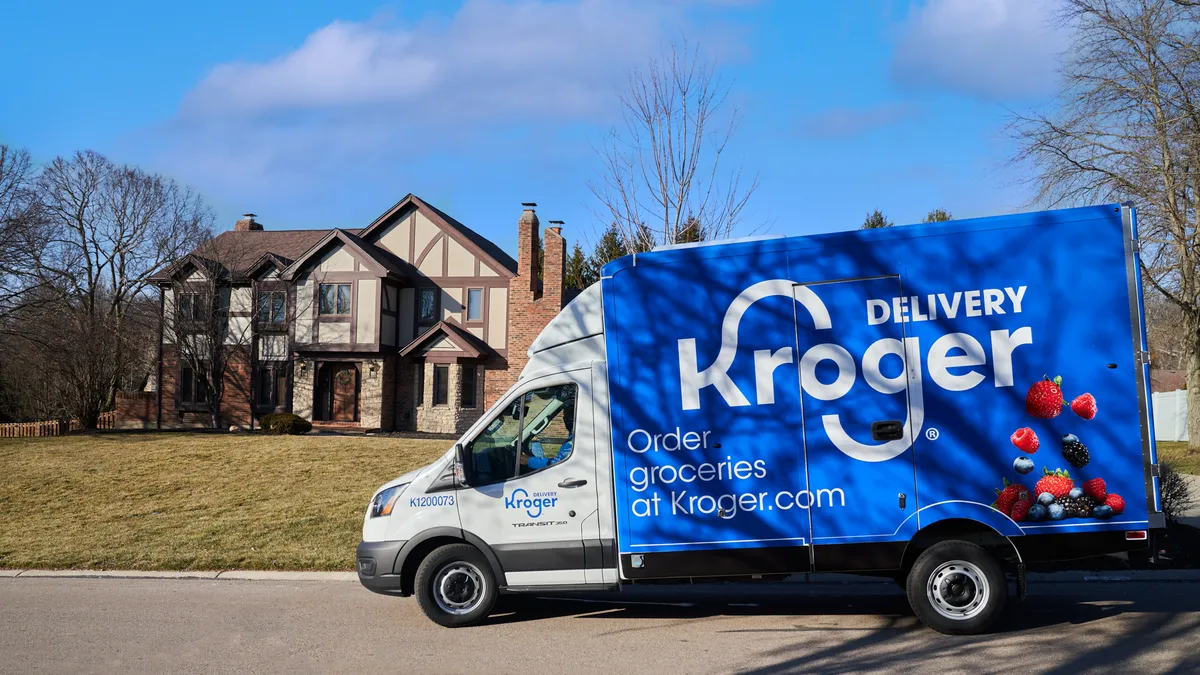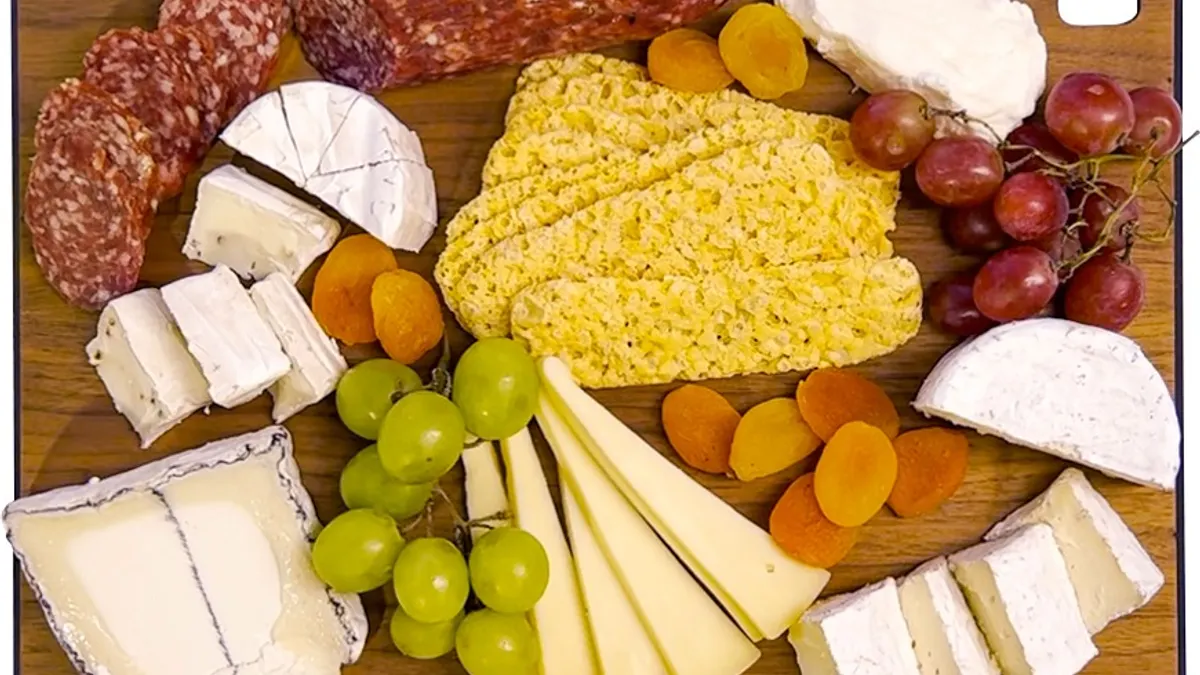Pardon the Disruption is a column that looks at the forces shaping food retail.
Two very unique models for online grocery delivery have grabbed headlines over the past few weeks. One is Kroger’s cavernous, automated customer fulfillment centers, or CFCs, the company officially unboxed last week and have begun filling orders in Ohio and Florida. The other is the ultra-fast delivery model that’s taken off in Europe and, to a limited extent, in the U.S., driven by tiny dark stores and a lofty promise of delivery in as little as 15 minutes.
These delivery modes couldn’t be more different — one takes a big, scything swing at e-commerce while the other throws scores of tiny darts at the opportunity. Looking deeper, they each present a drastically different response to a question that’s as old as food delivery and that’s getting reenergized as grocery e-commerce enters its post-pandemic phase:
How much does speed matter?
Kroger’s answer to that question seems to be: not as much as you’d think. Its automated CFCs can turn out a dizzying number of orders per day at an accuracy rate above 99%. They’re the most efficient way yet to churn out orders en masse, with Kroger estimating the facilities will eventually produce better order economics than in-store shopping.
But they’re not built for speed of delivery. Looming miles outside of city centers, with a delivery radius of over 90 miles, Ocado CFCs are set up for next-day orders. If they do handle same-day orders — a commitment Kroger and Ocado executives have sidestepped so far — it’ll have to happen outside of the 1- to 2-hour window many consumers have grown accustomed to in recent years.
Kroger has good reasons for pursuing this path. Ocado now turns a profit on its next-day e-commerce network in the U.K., where it operates four CFCs and more than two dozen cross-dock facilities as a standalone grocer. The tech firm’s CFCs are marvels of engineering, with thousands of robots zipping around grid arrays, passing within inches of one another — "the distance between them is less than the size of your pinky," according to Ocado CEO Tim Steiner. Grocers in countries like Japan, Canada and France have all sought a competitive advantage with this technology as they look to meet booming online demand while improving economics.
Kroger CEO Rodney McMullen recently estimated online grocery’s growth curve sped ahead four or five years last year. What better response to that new reality than cutting-edge robo-warehouses built for high volumes?
The facilities will be able to counter demands for faster service with better pricing. While same-day orders can carry fees as high as $10 per order, Kroger’s high-efficiency approach will probably result in the lowest delivery fees in the market and product pricing that matches in-store pricing. The grocer will also use its high-powered personalization capabilities to craft offers and get shoppers to try the service. That approach could train millions of online shoppers to adopt next-day delivery.
Kroger still plans to offer same-day service, but for the time being that will continue to happen from stores through third-party delivery providers like Instacart. During last week’s press conference, executives left the door open for smaller automated Ocado facilities like mini CFCs and micro-fulfillment centers (MFCs), but these didn’t appear to be a priority currently.
Data from Instacart, however, shows a faster, more localized approach to e-commerce is increasingly what shoppers are looking for. As part of its annual insights report issued earlier this month, the company surveyed just over 2,000 shoppers on whether they'd prefer to receive their grocery orders in two hours or less, in five hours or less, or beyond that. Eighty-five percent chose the two hours or less option.
Instacart reported in 2020, 95% of customer orders with 15 items or less were delivered within two hours, while 50% were delivered in under an hour.
“Gone are the days of two-day delivery; customers now expect to get their groceries in as fast as two hours — if not much faster," Instacart wrote in its report.
Kroger’s CFCs are built to handle stock-up shops, not orders of 15 items or less. But what if those stock-up shops, which operate under the thinking that most shoppers want to complete fewer trips and maximize their baskets when they do so, are becoming less relevant to shoppers?
I’d argue that trend was already happening before 2020, and the pandemic has supercharged it. Stuck at home, glued to their phones, consumers have gravitated toward the speedy gratification of takeout service. Count me as Exhibit A here. I regularly pull up my preferred restaurant delivery app and queue up a lunch delivery that usually arrives within the hour. The time between needing food and getting food still feels miraculous.
“The last 12 months has changed our habits and value of time,” Jason Soar, a former grocery e-commerce lead for Sainsbury’s in the U.K. and now founder and CEO of consulting company ThinkThru, told me recently. “The next great bastion of change will be our attitudes toward how and when we shop for groceries, and whether we may plan ahead or not. Add to that the generational shift. I look at my kids and think they will never do anything but shop on-demand."
Indeed, many shoppers don’t want to plan their meals and shopping trips ahead of time, and innovations in on-demand delivery promise they won’t have to. That brings us to the ultrafast delivery trend that’s raised almost $14 billion lately, according to a Financial Times analysis, citing PitchBook data. These businesses are dropping small dark stores in densely populated urban areas, whipping up demand within anywhere from one to three miles and using small armies of workers, often riding bikes or scooters, to make deliveries.
The frothy funding environment here and promise of 15-minute delivery makes the trend sound more like a fad. But I think ultrafast delivery firms are onto something because they’re filling basic shopping needs that traditional grocery e-commerce have struggled with: impulse shopping, small trips and fill-in shops. These companies, including Weezy, Jiffy, Gorillas, Gopuff and Fridge No More, charge low (or in some cases no) delivery fees and offer a curated assortment that’s ideally suited for app browsing. This is in contrast to the 30,000-plus items carried by a traditional supermarket, which I've found is mainly conducive to shopping via the search bar.
Frank Beard, a retail consultant who has studied online convenience firms in the U.S. like Gopuff and DashMart, said the difference between 15 minutes and 30 minutes is likely negligible when it comes to delivery. The bigger distinction, he said, is between on-demand and planned ordering.
“You've got really two buckets,” he said. “You've got some companies that are very specifically targeting those small basket sizes, who need it now, and then you've got the retailers that are trying to target the large basket sizes with $200 and up.”
"The last 12 months has changed our habits and value of time. The next great bastion of change will be our attitudes toward how and when we shop for groceries, and whether we may plan ahead or not."

Jason Soar
Founder and CEO, ThinkThru
Which camp has the edge right now? Soar is bullish on the future for on-demand delivery firms. And as the former head of Chop Chop, the first on-demand grocery service among the U.K.’s “big four” supermarket chains, he knows a thing or two about the subject. He said the glut of firms that have flooded the market will consolidate over time and figure out better business models. They’ll also likely evolve beyond their focus on primarily impulse buys like alcohol and snacks. In the U.K., Weezy draws from a marketplace of local food vendors, while New York City’s Fridge No More carries fresh meat, seafood, baked goods and other grocery staples.
"[On-demand grocers] are super small in the grand scheme of things. But there's enough interest in them that tells me that there's something bigger at stake here," Soar said.
Jordan Berke, a former Walmart executive who now leads Tomorrow Retail Consulting, sees ultrafast delivery firms as yet another force pulling major retailers into faster fulfillment options, including sub-one-hour delivery. Like Soar, he noted the pandemic has “socialized” consumers to shopping on their phones and looking for speedy delivery and pickup.
“Thirty minutes is where I think most grocers are going to land as part of their offering,” he said. “I suspect that a year and a half from now, one and a half hours will be the standard delivery time for grocery, and there will be an instant offering, a faster offering, that’s available for a premium.”
That's already starting to happen, with Walmart, Hy-Vee and FreshDirect all introducing "express" order options. Kroger also piloted a 30-minute "Rush" delivery service near Cincinnati a few years back, but the company hasn't provided any updates.
If consumers as a whole and young shoppers in particular are prioritizing order speed, then Kroger’s CFCs could eventually become outdated. The company needs millennials and Gen Z, the generations that have grown up with phones in their hands, ordering large-basket grocery orders as their spending power increases and they have more influence over household spending. At the very least, Kroger likely needs to come up with a better, faster same-day delivery option or risk getting left in the dust.

















